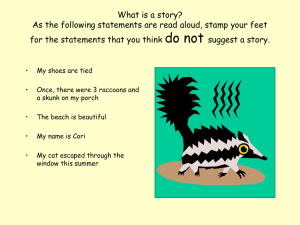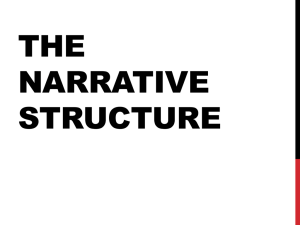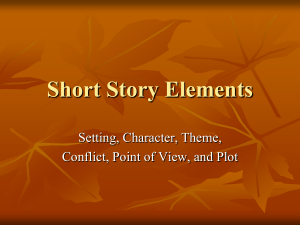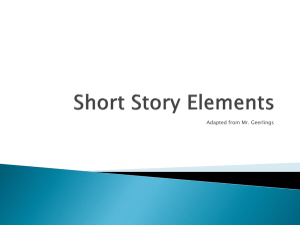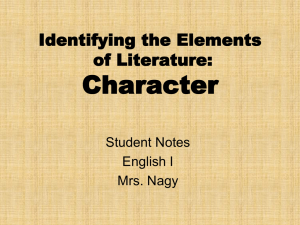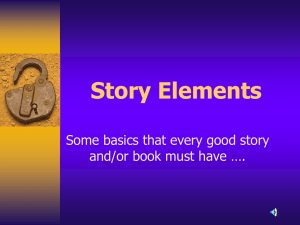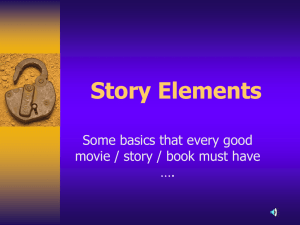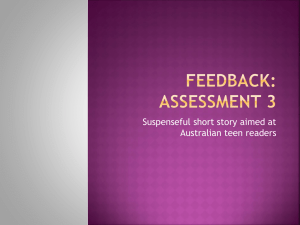Short Story PP 2P
advertisement
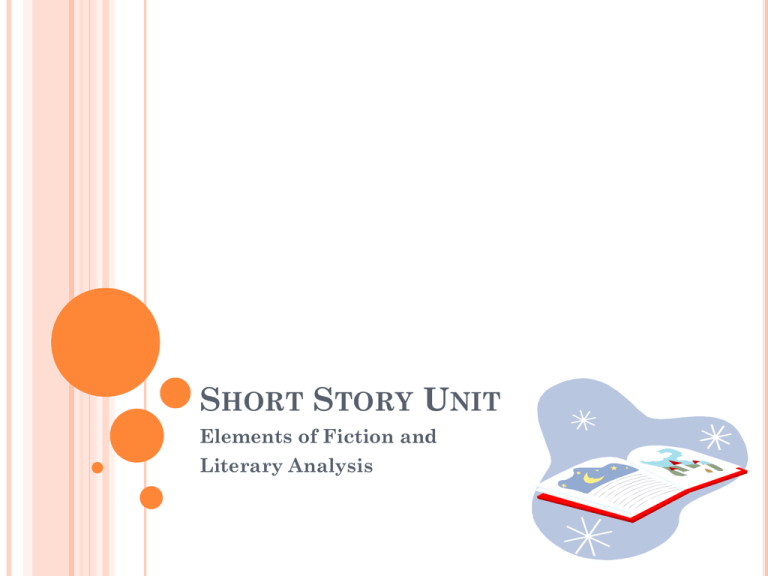
SHORT STORY UNIT Elements of Fiction and Literary Analysis What is a short story? Have you ever read a short story? What are the parts of a short story? If so, which one? WHAT IS A SHORT STORY? Short stories usually lack detail. Short stories are brief. Short stories use P.A.C.T.S. to establish the narrative. The short stories that we are going to read are fictional WHAT IS FICTION? Fiction is a story that is not true. It is not based on any real facts. Remember….Fiction= Fake Some examples of fiction may include: Novels Short Stories Video Games Plays Movies Comics Television (non- reality) P.A.C.T.S. Short stories use P.A.C.T.S to build the narrative. P.A.C.T.S. is an acronym for the elements of fiction. Although short stories may use all of the aspects of P.A.C.T.S, the author may choose to focus on any one of these elements: Plot Atmosphere/Mood Characterization Theme Setting PLOT The plot is essentially what happens throughout the story. The events of the plot graph can be categorized into 6 main parts: Exposition/Introduction Inciting Incident Rising Action Climax Falling Action Resolution SHORT STORY PLOT GRAPH Climax Rising Action Falling Action Resolution Exposition/ Introduction Inciting Incident PLOT GRAPH 1. Exposition/Introduction- The beginning of the narrative. It introduces the characters, setting, and it may introduce the conflict. 2. Inciting incident-This is the initial problem in the narrative that causes the conflict or action to occur. 3. Rising Action- The rising action is the main part of the story. It builds the reader’s suspense through a series of crisis and conflict. PLOT GRAPH 4. Climax- This is the turning point of the narrative. This is the part in the plot where the conflict escalates to the point of no return. 5. Falling Action- This is the part of the narrative when the conflict begins resolution. 6. Resolution- The conflict is resolved and loose odds and ends are tied up. This is the conclusion of the story. THE LION KING Watch this trailer for the movie and fill in your plot diagram http://www.youtube.com/watch?v=f0fReuRs890 ATMOSPHERE/MOOD The atmosphere or mood is the emotions that are presented in the narrative. The setting helps to establish the atmosphere or mood in the story. Some examples of atmosphere or mood include: Tense Relaxed Mysterious Dark Anxiousness Bright/ Happy SETTING The setting informs the reader of the time and place that the events of the story take place. To explore the setting in a narrative, look for the following details: Room, place, or location Decoration that is around What it looks like Time of day- morning, evening, night, sunrise, etc. Day, month, year, or decade Historical time period, geography, or culture Mood/Atmosphere – remember yesterday’s note? SETTING Watch the following video, and fill out your organizer to explore the elements of setting. First 10 mins of CSI or Law and Order or other police drama. CHARACTERIZATION Protagonist- The protagonist is the main character in the story. The plot revolves around the protagonist. Antagonist- The antagonist is the person or force that challenges or confronts the protagonist. The antagonist is against the protagonist. CHARACTERIZATION Watch this video clip from Harry Potter. List the characteristics of both Harry Potter and Lord Voldemort in your organizer. What do you notice about each character? How are they similar? How are they different? Look at their voices, powers, appearance, and body language. Watch this video clip of Spiderman and Venom. List the characteristics of both Spiderman and Venom in your organizer. CHARACTERIZATION Major Characters- Major characters are characters that have a primary role in the narrative. The protagonist and antagonist are almost always major characters. Minor Characters- Minor characters are characters that support the protagonist and antagonist. They play a smaller role in the narrative. CHARACTERIZATION Round Characters – a character that has many qualities to their personality. These characters grow, evolve, or change throughout the story. Flat Characters – a character that has limited qualities to their personality These characters stay the same throughout a story without much of a change CHARACTER ARCHETYPES An archetype is an accurate stereotype that seems to repeat itself from text to text (movie to movie, tv show to tv show). This repetition can be called a pattern. The characters in a narrative can be groups into 5 standard archetypes: The clown- the funny, silly, comedic one The wise one- the older, experienced one The hero- the courageous leader The villain- the evil, mischievous character The seducer/temptress- the romantic, charismatic one THEME The theme is the meaning or message of a story The writer tries to present an idea about the main subject. Ex: Titanic – Love is everlasting Ex: Hunger Games – Appearances can be deceiving

